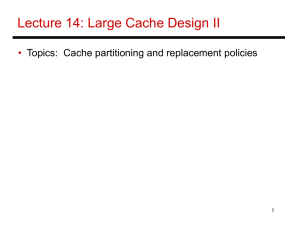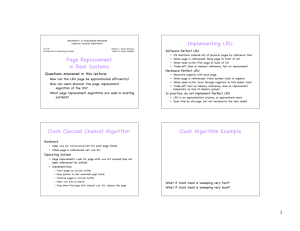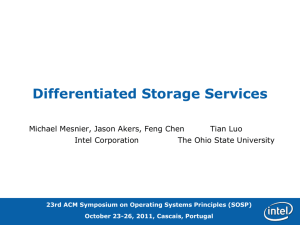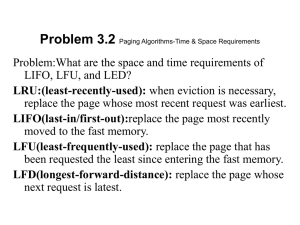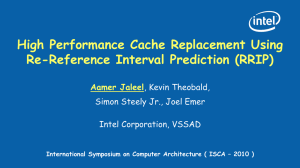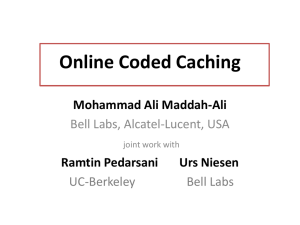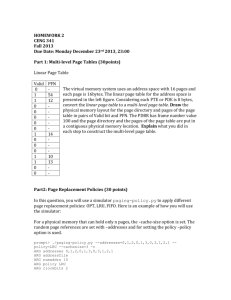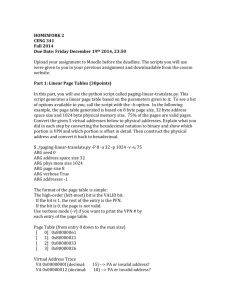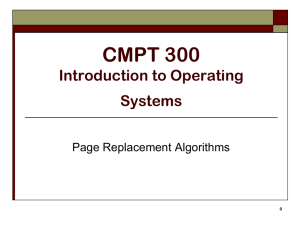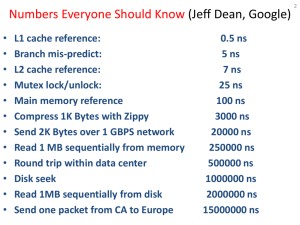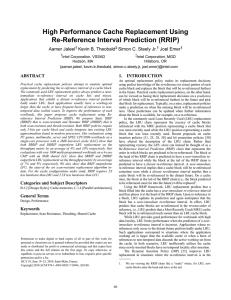Topic7-Cache_RRIP - Ann Gordon-Ross
advertisement
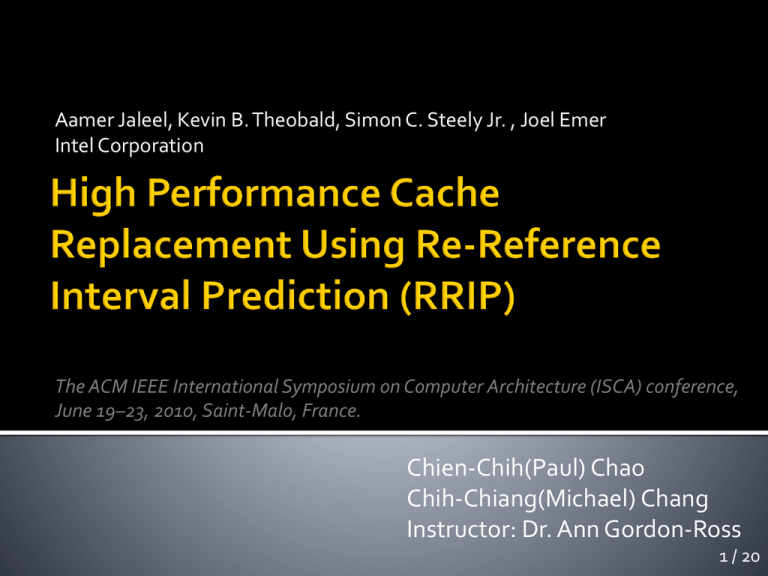
Aamer Jaleel, Kevin B. Theobald, Simon C. Steely Jr. , Joel Emer Intel Corporation The ACM IEEE International Symposium on Computer Architecture (ISCA) conference, June 19–23, 2010, Saint-Malo, France. Chien-Chih(Paul) Chao Chih-Chiang(Michael) Chang Instructor: Dr. Ann Gordon-Ross 1 / 20 Motivation Background Least Recently Used (LRU) policy Dynamic Insertion Policy (DIP) Least Frequently Used(LFU) policy Re-Reference Interval Prediction (RRIP) Not Recently Used policy Static RRIP Dynamic RRIP Experimental Methodology Results and Analysis Conclusion 2 / 20 Cache stores the frequently required data Discard items to make room for the new ones when cache is full. http://i.crn.com/enc/CACHEMEM.GIF http://en.wikipedia.org/wiki/Cache_algorithms http://www.mymodernmet.com/profiles/blogs/2100445:BlogPost:33176 3 Efficient last-level cache(LLC) utilization Avoid long latency cache misses to main memory Need a practical cache replacement policy that is not only thrash-resistant but scanresistant 4 LRU Replacement Policies DIP (Improvement of LRU) Cache Access Patterns LRU/ LFU Hybrid replacement policy Comparison of DIP and Hybrid(LRU/LFU) Improving LLC performance by targeting cache blocks that are dead upon cache insertion 5 Least Recently Used(LRU) LRU Chain: LRU / MRU Re-Reference Interval Prediction (RRIP) chain Near-immediate Distant Good with high data locality Bad performance when re-references only occur in the distant future. 6 Improves LRU replacement by dynamically changing the re-reference prediction Both DIP and LRU are failed t0 make accurate predictions when mixed re-reference patterns occur Scan: a burst of references to data whose re- reference interval is in the distant future 7 Recency-friendly Access Pattern Thrashing Access Pattern Streaming Access Pattern Mixed Access Pattern http://www.islington.gov.uk/education/libraries/borrowingfromlibrary.asp 8 Recency-friendly Access Pattern 9 Thrashing Access Pattern 10 Streaming Access Pattern 11 Mixed Access Pattern 12 Least Frequently Used(LFU) frequently accessed : near- immediate future infrequently accessed : distant future Measured by counter Features: DIP: Thrash-resistant LRU/LFU: Scan-resistant 13 14 Not Recently Used (NRC) replacement policy Static RRIP SRRIP with Hit priority SRRIP with Frequency priority Dynamic RRIP Behavior for a Mixed Access Pattern Experimental methodology and Results Simulator Benchmark 15 / 20 Motivation LRU cannot perform to mixed access patterns Chained-based LRU is impractical for highly associative caches The nru-bit Value of ‘1’ implies was recently used and is predicted to be re-referenced in the near-immediate future Value of ‘0’ implies was not recently used and is predicted to be re-referenced in the distant future 16 / 20 Motivation One bit of information is not enough NRU cannot identify non-scan blocks in a mix access pattern M-bit Re-Reference Prediction Values (RRPV) 2M possible RRPV eables intermediate re-reference intervals predicton Hit Priority (HP) Updates RRIP to be near-immediate on a hit Prioritize replacement of blocks with no hits Frequency Priority Decrementing the RRPV register on cache hits Prioritize replacement of blocks with infrequently re-ref 17 / 20 Mixed Access Pattern a1, a2, a2, a1, b1, b2, b3, b4, a1, a2 Cache Hit: Move block to MRU Cache Miss: Replace LRU block Move block to MUR 18 / 20 Mixed Access Pattern a1, a2, a2, a1, b1, b2, b3, b4, a1, a2 Cache Hit: 1. Set nru-bit of block to ‘0’ Cache Miss: 1. 2. 3. 4. 5. Search for first ‘1’ from left If ‘1’ found go to step (5) Set all nru-bits to ‘1’ Go to step (1) Replace block and set nru-bit to ‘0’ 19 / 20 Mixed Access Pattern a1, a2, a2, a1, b1, b2, b3, b4, a1, a2 Cache Hit: 1. Set RRPV of block to ‘0’ Cache Miss: 1. 2. 3. 4. 5. Search for first ‘3’ from left If ‘3’ found go to step (5) Increment all RRPVs Go to step (1) Replace block and set RRPV to ‘2’ 20 / 20 Motivation SRRIP does not thrash-resistant Bimodal RRIP (BRRIP) Similar to Bimodal Insertion Policy of DIP Insert majority of cache blocks with distant re-ref Insert infrequently with a long re-ref interval Set Dueling Choose between scan-resistant SRRIP and thrash- resistant BRRIP by using two Set Dueling Mointors Use a single policy selection counter 21 / 20 Simulator CMP$IM 4-way out-of-oreder 128-entry reorder buffer 3 level cache hierarchy Benchmarks 5 workloads from SPEC CPU2006 9 “real world” workloads ▪ PC Games ▪ Multimedia ▪ Server 22 / 20 Reduces MPKI by 5-18% Outpeform LRU by an average of 2.5% 23 / 20 Reduces MPKI by 5-15% Outpeform LRU by an average of 5% 24 / 20 SRRIP is insensitive when M>3 Wider RRPV retain blocks for longer periods 2-bit or 3-bit RRPV is sufficient to be scan-resistant 25 / 20 Improve avg 5% above SRRIP 26 / 20 Base on single-core processor with 16way 2MB LLC RRIP requires less hardware than LRU yet outperform LRU on average RRIP requires 2.5X less hardware than HYB 27 / 20 RRIP predicts intermediate re-ref between near-immediate and distant re-ref interval SRRIP needs only 2-bit for scan-resistant DRRIP for both scan-resistant and thrashresistant SRRIP and DRRIP outperform LRU by an average of 4% and 10% 28 / 20
